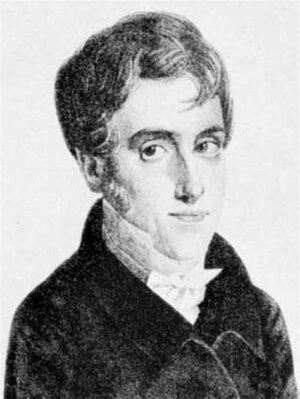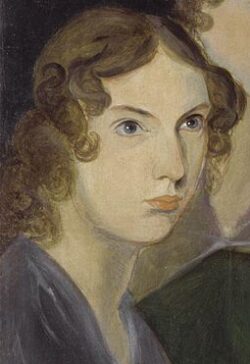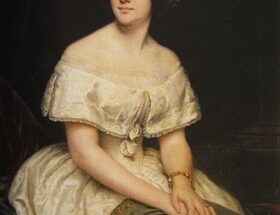
Early life
Jane Burden was born on 19 October 1839 in Oxford. She was the daughter of Robert Burden, a stableman, and his wife Ann Maizey, who was a domestic servant. At the time of her birth, her parents were living at St Helen’s Passage, in the parish of St Peter-in-the-East, off Holywell Street in Oxford. Little is known of Jane’s childhood, but it was certainly poor.
In October 1857, Jane and her sister Elizabeth attended a performance of the Drury Lane Theatre Company in Oxford. Jane was noticed by Dante Gabriel Rossetti and Edward Burne-Jones who were members of a group of artists painting the Oxford Union murals, based on Arthurian tales.
Struck by her beauty, they asked her to model for them. Jane sat mostly for Rossetti as a model for Queen Guinevere and afterwards for William Morris, who was working on an easel painting, La Belle Iseult. During this period, William Morris fell in love with Jane Burden and they became engaged, though by her own admission she was not in love with him.
Jane’s education was limited and she probably was destined to go into domestic service like her mother. After her engagement, she was privately educated to become a gentleman’s wife. Her keen intelligence allowed her to recreate herself. She was a voracious reader who became proficient in French and Italian,as well as an accomplished pianist with a strong background in classical music.
Her manners and speech became refined to an extent that contemporaries referred to her as “queenly.” She also became a skilled needlewoman, self-taught in ancient embroidery techniques, and later became renowned for her own embroideries.
Marriage & Career
Jane Burden married William Morris at St Michael at the Northgate in Oxford on 26 April 1859.[5] After the marriage, the newlyweds moved to the quasi-medieval Red House in Bexleyheath, Kent. While living there, they had two daughters, Jane Alice, born 17 January 1861, and Mary, born 25 March 1862.
Soon they moved to 26 Queen Square in London, which they shared with the design firm of Morris, Marshall, Faulkner & Co., and later bought Kelmscott House in Hammersmith as their main residence. Although Jane, her daughters Jenny and Mary, and her sister Elizabeth all supervised and embroidered for Morris & Co., credit for the designs were given to William Morris himself “in the interests of commercial success.”
In 1871, William Morris and Dante Gabriel Rossetti took out a joint tenancy on Kelmscott Manor on the Gloucestershire–Oxfordshire–Wiltshire borders. William Morris went to Iceland, leaving his wife and Rossetti to furnish the house and spend the summer there.
Jane Morris had become closely attached to Rossetti and became a favorite muse of his. Their romantic relationship is reputed to have started in the late 1860’s and lasted, on differing levels, until his death in 1882. They shared a deep emotional connection and she inspired Rossetti to write poetry and create some of his best paintings. Her discovery of his dependence on chloral hydrate, which was taken for insomnia, eventually led her to distance herself from him, although they stayed in touch until he died in 1882.
In 1883, Jane met the poet and political activist Wilfrid Scawen Blunt at a house party given by her close friend, Rosalind Howard. There appears to have been an immediate attraction between them. By 1887 at the latest, they had become lovers. Their sexual relationship continued until 1894 and they remained close friends until her death.
Death
Despite her husband’s socialism, Jane remained a supporter of the Liberal Party until her death. She was also an ardent supporter of Irish Home Rule.
A few months before her death, she bought Kelmscott Manor to secure it for her daughters’ future. However, she did not return to the house after having purchased it.
Jane Morris died on 26 January 1914, while staying at 5 Brock Street in Bath. She is buried in the churchyard of St. George’s Church in Kelmscott.
Jane Morris’s Embroidery


Paintings of Jane Morris by Dante Gabriel Rossetti





Paintings of Jane Morris by William Morris




